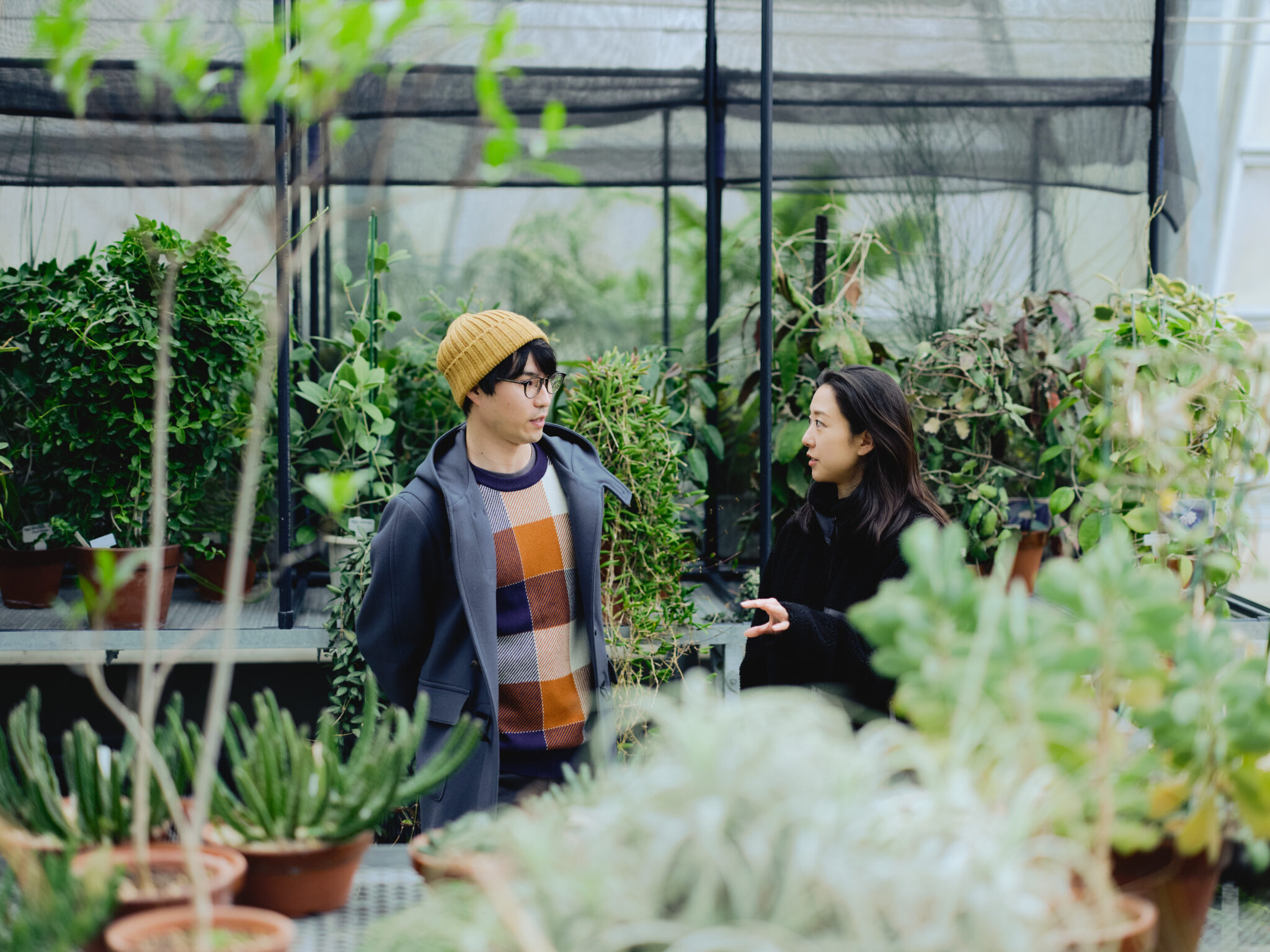Series: The Search for New Seeds of Shikohin Ideas
According to the 7th Edition Kojien (Japanese dictionary), shikohin is defined as “Food or beverages that are consumed for flavor, fragrance and stimulation over nutritional value. Examples include alcohol, tea and coffee.” Nonetheless, many people would also describe shikohin products as a necessity in their day to day lives. If shikohin products do not provide us with any nutritional value, are they really a necessity?
Rei Horie, founder of craft gin maker HOLON, believes otherwise. She says, “Shikohin provides nourishment to our souls that gives us the energy to carry on in our daily lives.”
So what role will shikohin play in our ever changing world and unforeseen future?
In this new series, “The Search for New Seeds of Shikohin Ideas” Rei Horie will meet with experts from various fields to identify and record new seeds of possibility in the world of shikohin. These records will assist in the sprouting of such seeds in the near future.

For the first article of this series we visited Ko Mochizuki, a botany and biodiversity researcher at Tokyo University Graduate School of Science’s Koishikawa Botanical Garden.
Plants are the raw material for all types of shikohin products. The aromas that are emitted by such raw materials are a major element in the shikohin experience. Which brings us to the question, why do plants emit fragrances and why do humans perceive such fragrances as being pleasant? Mochizuki researches flowers and pollinators such as insects to analyze the fragrances emitted by plants. We spoke about future possibilities surrounding plants, fragrances and shikohin products.
How do flowers attract insects? The intimate relationship between the two organisms
Horie: Your research focuses on the relationship between flowers and insects and how flowers work to attract insects to them. First off, I want to ask about the reasons why flowers want to attract insects in the first place. I know that insects carry pollen across flowers and assist in pollination, so is it mostly for reproductive purposes?
Mochizuki: In most cases, the goal is pollination. When people think of pollinators, many think of butterflies and bees, but other insects such as flies, moths, bats and birds also help to carry pollen. In fact, not many plants are pollinated by butterflies. One flower that is pollinated by butterflies is the lily.
The eyesight of bees and butterflies are very high in color resolution. The swallowtail butterfly, for example, has six color receptors while humans only have three. They see a much more colorful and vivid world than we do. They rely heavily on color when selecting flowers so they are also attracted to plants that are not necessarily very fragrant. To give an example besides insects, birds also rely almost 100% on vision to select flowers and many plants that depend on birds to pollinate have almost no fragrance at all.
Flowers that do produce a strong fragrance attract organisms such as flies, moths and bats that have less developed vision or are nocturnal. Moon lilies, which open their white flowers at night, are famous for their jasmine-like fragrance and are pollinated by bats. The Ylang Ylang, which is often used in perfumes, are pollinated by small insects such as sap beetles and moths which humans may consider as pests.

Horie: It’s interesting that flowers which people tend to prefer attract insects and animals that are otherwise considered pests. Are there insects that are attracted to flowers through both vision and scent?
Mochizuki: I think there are many. One example is the bumblebee, which is one of the most active of pollinators. Plants that are pollinated by bumblebees are characterized as having blue-purple or yellow color and a terpene scent.(*1) The blue-purple color alone will attract insects, but the terpene scent also acts to assist the insects’ memory, so having both color and fragrance is beneficial.
How the flower attracts insects and animals depends on which insect or animal the flower is targeting, and they adapt to target the senses of those organisms. Plants have evolved their current shape and fragrance based on the behavior of pollinators.
(*1) Terpene: The primary constituents of essential oils that are responsible for its natural fragrance. Among commercially produced essential oils, the following are the most widely produced and valued. (Lemongrass oil) citral, (needle oil) α-Pinene, (orange oil) limonene, etc. (Source: Encyclopedia of Japan)

Horie: We talked about why flowers try to attract insects, but what are some things that insects look for when approaching flowers?
Mochizuki: There are about three patterns in why insects seek out flowers. One is when they are looking for nectar or pollen or they want to eat the flower itself. For example, the Agapetes grandiflora, which is a kind of azalea plant, produces nectar from its buds and flowers after it finishes blooming and ants come to lick that nectar. The ants act as a kind of bodyguard for the flower because it gets rid of other insects. Plus, once one ant finds the nectar it comes back with many other ants from their group, which is also beneficial for the flower.
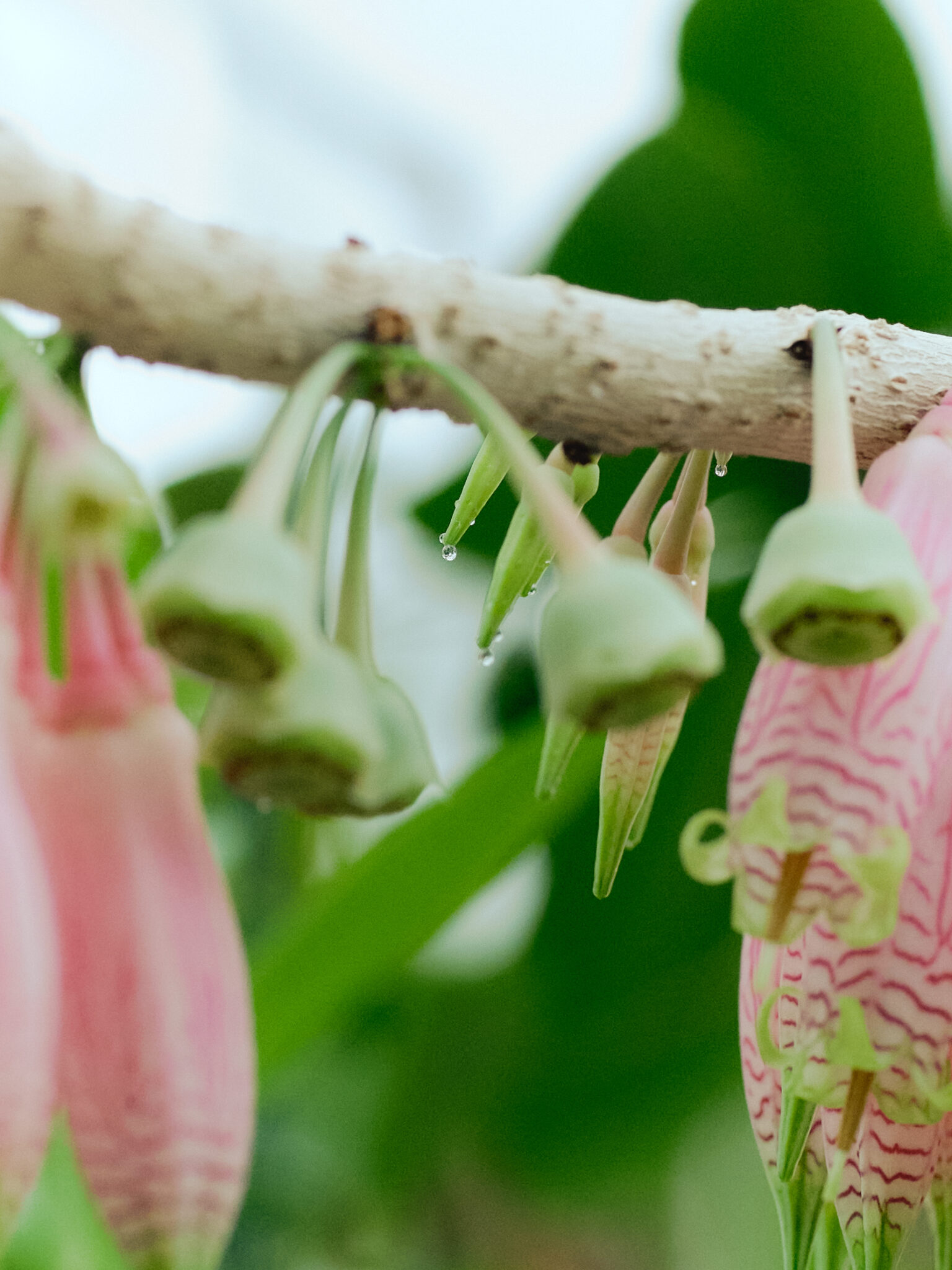
Horie: I knew that insects seek the nectar of flowers, but I didn’t know that insects also eat the flowers themselves.
Mochizuki: Flowers have a shorter lifespan compared to leaves. Even flowers with relatively long lifespans only last about one month. Flowers are but a fleeting organ that is not a top priority for the plant itself to protect. Oftentimes, flowers do not contain toxic or poisonous substances that are otherwise found in leaves and this makes them easier for insects to eat.
Another pattern is when insects are tricked into approaching the flower. For example, many species of the orchid family are known to attract male insects by mimicking the shape of a female insect.
The third pattern is when insects approach flowers in order to hunt other insects. One example is how some wasps approach flowers of the Apiaceae family. They are known to hunt the small insects that gather on the flower while also drinking its nectar.
Horie: All these reasons are based on functionality. Although oftentimes humans choose flowers based on our preferences of fragrance or for simple enjoyment, it seems that the behavior of insects is based on survival and reproduction.

Attracting insects with foul odors and defending flowers with fragrance. The unknown strategies plants use with scent
Horie: In researching the mechanisms of plants and fragrance, I found that there are two patterns that exist. One is attraction and the other is defense. You shared some examples on how plants attract insects, but what about the use of fragrance as a defense mechanism?
Mochizuki: Plants contain fragrances for both attraction and defense. I mentioned the example of the azalea and ants earlier. From the plant’s perspective, it is beneficial for the ants to come to its stems and leaves, but if the ants are around the flowers they will get in the way of pollinators. For this reason it is said that flowers produce fragrances that ants dislike, such as terpenes.
Horie: The plant wants protection from the ants but it does not want them around its flowers. It seems like plants can be quite cunning. (laughs)
Mochizuki: There is a flower that attracts insects with a unique scent. The Stapelia is a member of the Asclepiadaceae family which is native to South Africa. Try smelling it up close.

Horie: Wow, it has a very foul odor! It smells like garbage or something rotten.
Mochizuki: Yes, it is the odor of decomposing proteins so it is the smell of rotting meat, rather than rotting vegetables. The reason this plant emits this odor is because flies are its pollinators. Flies are attracted to animal carcasses and feces so they are lured to this plant and lay eggs in its flowers. They mistake the flowers for carcasses or feces which they use to raise their offspring. In terms of aromatic substances, it is emitting Dimethyl disulfide and Dimethyl trisulfide, which has the same components as sulfur.

Horie: We tend to imagine flowers as using pleasant fragrances to lure organisms to them, but it’s interesting to learn about such an opposite example.
The fact that flowers use fragrance as a defense mechanism is also very interesting. I had an understanding that flowers are the attractant and the leaves are the defense.
Mochizuki: It’s true that there are many examples of leaves being the defense mechanism in many plants. However, flowers do not welcome everything either. If they wanted to attract all living things, they wouldn’t evolve to have such a foul odor. (laughs)
I always use a machine called a gas chromatograph mass spectrometer to analyze fragrances. It is an excellent machine that separates fragrance compounds in plants to show how much of each component it contains. The plants that I am currently researching have 10 compounds and of them, two are effective in attracting insects. However, both of these compounds are ineffective on their own. Their effect in creating an alluring fragrance only happens through the combination of multiple compounds, and the more compounds it has the more effective they become.
Horie: I guess you can say that complex fragrances work better to attract more insects.

Caffeine in flowers? Hints for new shikohin found in the keyword “addictive”
Mochizuki: Alkaloid (*2) is a chemical substance that is well known for providing defense mechanisms. Common examples of alkaloids are caffeine, capsaicin and nicotine.
(*2) Alkaloid: A term used to describe certain substances found in organic plant-based material that contain at least one nitrogen atom. In general they can have strong physiological effects on animals with only a small amount. Examples include nicotine, morphine, cocaine, aconitine, quinine, etc. (Source: Digital Daijisen)
Horie: All of these examples have addictive effects. The more I explore shikohin products, the more I define them as things with “addictiveness x fragrance”. I believe it triggers the reward system in our brain by making us feel good and makes us want to have more. I am very interested in plants with addictive properties.
Mochizuki: These chemical substances are often found in the leaves of the plant. As I mentioned earlier, the leaves often provide the defense mechanisms in the plant. Since this is not within the realm of my research I cannot give detailed examples, but leaves contain these substances to chase away animals by giving them some kind of stimulation when eaten.
On the other hand, research has shown that there are cases where caffeine is used to attract insects. There are coffee and tangerine plants in South America that contain caffeine in their nectar. To many people’s surprise, the bees that pollinate those flowers have been found to have increased memory capacity when they ingest caffeine, and this results in their visiting that flower more frequently.
One study gave bees several different concentrations of caffeine and examined the changes in memory capacity. They found that too much or too little caffeine has no effect, while just the right amount enhances memory capacity.
Horie: I didn’t know caffeine can have physical effects on organisms besides humans!

Mochizuki: The research on such effects have only been conducted on the flowers of these coffee and tangerine plants so far. However, it would not be surprising if we find other plants that contain caffeine in their nectar if the plant has the capacity to biosynthesize caffeine. If we look into the camellia genus or coca plants (such as chamomile and coca), we may find that it not only contains caffeine in its leaves but in the nectar of their flowers as well.
Horie: So although we know of plants that contain caffeine, it is yet to be studied if their flowers also contain caffeine substances . It would be very interesting to research this and make new products such as a caffeinated honey, and that could lead to the development of brand new shikohin products.
Mochizuki: If we do such research and look into the relationship between insects and flowers that have caffeine, we may discover something new. It is quite easy to analyze caffeine content so I would be happy to help out.
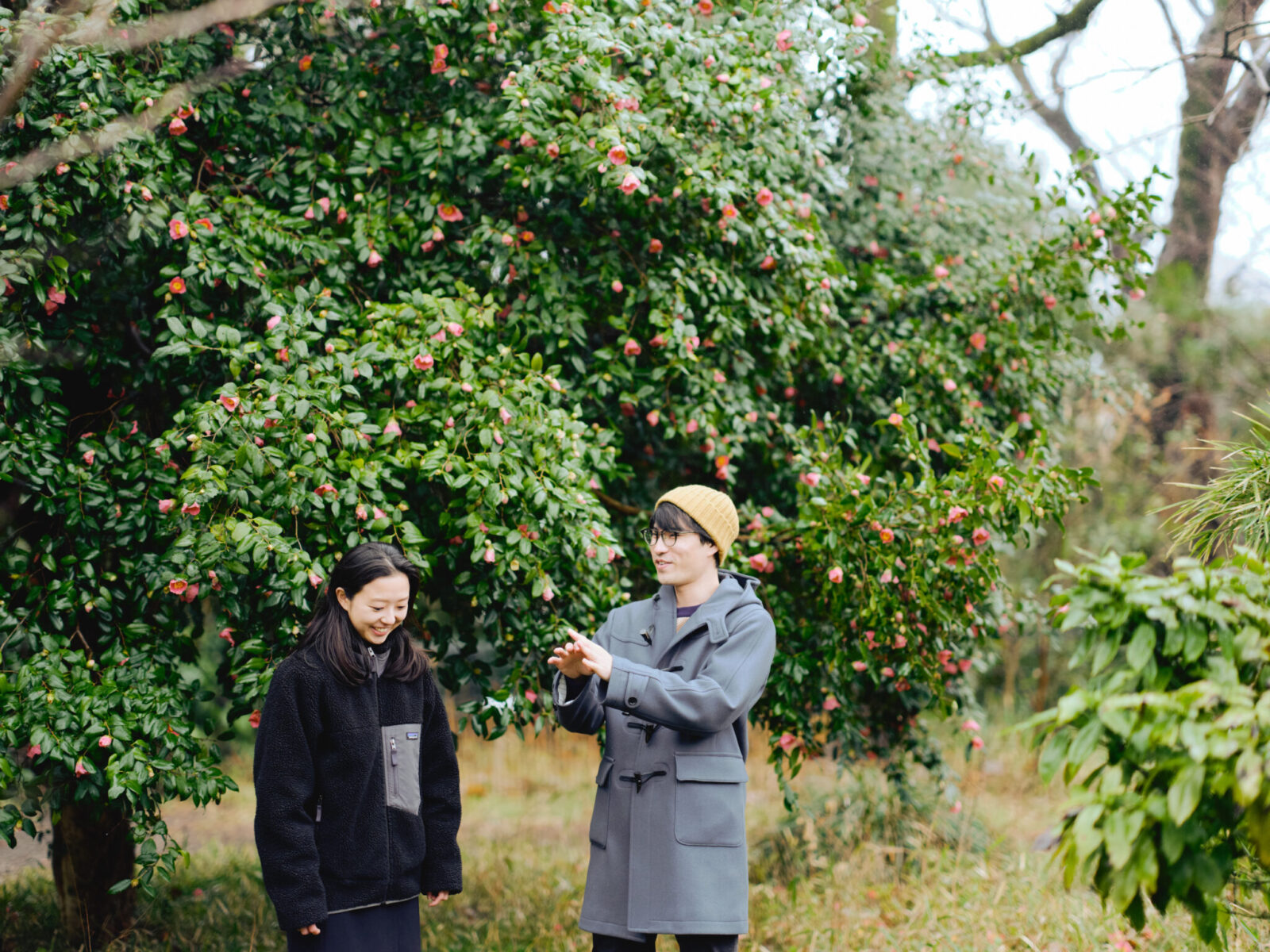
The science behind why humans find the fragrances of plants to be pleasant
Horie: So far we have discussed the relationship between insects and flowers. I would like to delve deeper into the topic of fragrances and their addictive nature from the perspective of humans and shikohin products.
I believe that there are two main roles for the sense of smell in humans. One is to pick up on danger and is a way to protect our health and life. The second is to bring changes to our emotions. I think that this second function influences our nervous system and helps us relax or control our emotions. While I feel that the effect on emotion is a very human function, the first function on picking up on danger is true for insects as well.
Mochizuki: The ability to identify what is safe to consume is just as important as being able to identify what we should not consume. Insects and humans alike are attracted to the scent of fruits and nectar. There are some flowers that utilize this attraction and produce a scent that is similar to fruit in order to attract insects. Ylang-ylang is one example of a plant that attracts insects by emitting a scent that is similar to ripe fruit. We humans also find its fragrance to be very pleasant. It is a kind of fragrance that both insects and humans actively pursue.
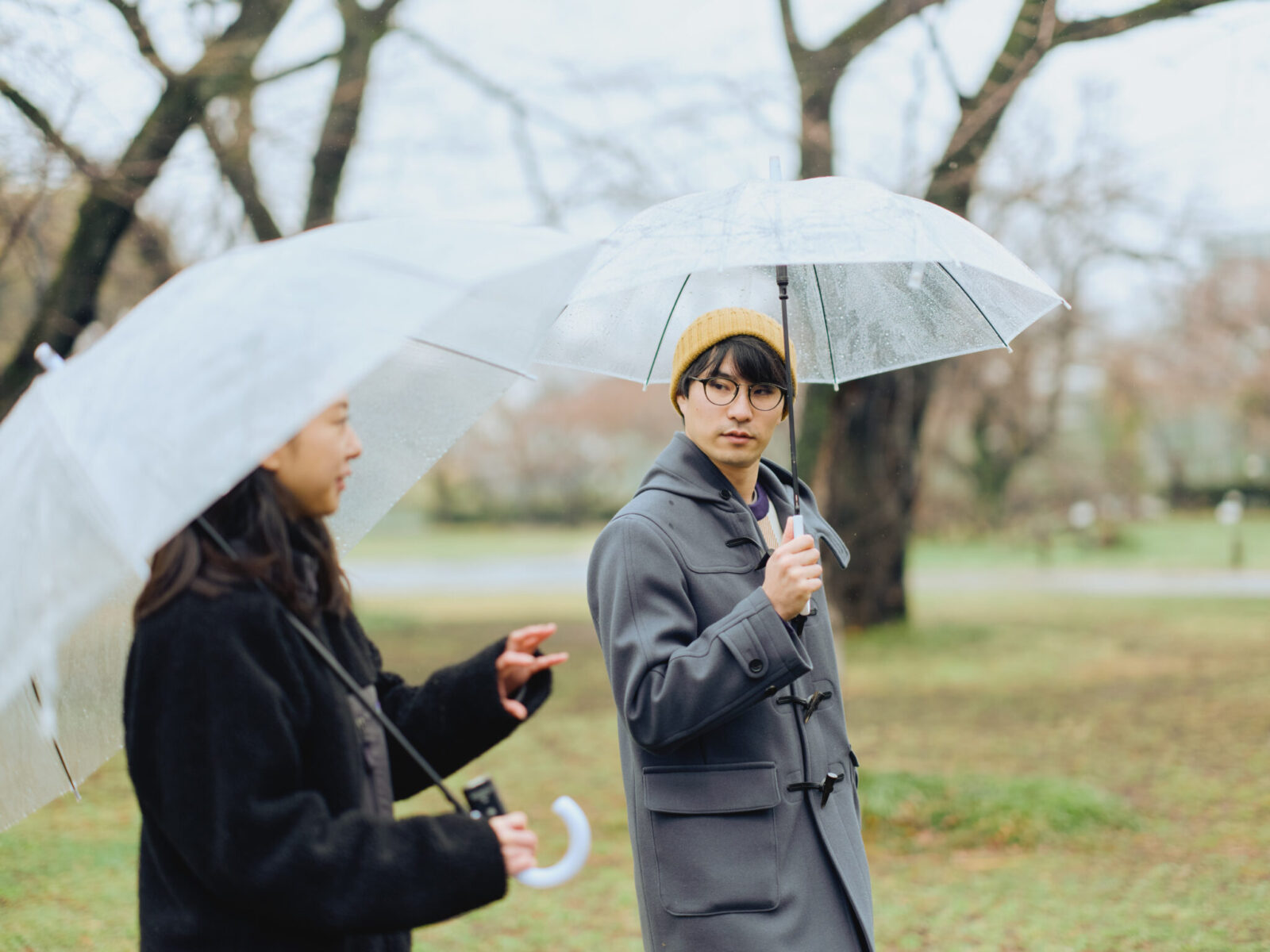
Horie: Perhaps there are scents that we consider pleasant that come from physiological desires and scents we are attracted to from a more preferential desire.
Mochizuki: I think so. That is why I find it very mysterious as to why humans perceive flowers as having a pleasant scent. Humans do not really eat flowers for nutrition and our reproductive system is also unrelated to flowers. Perhaps there was some kind of evolutionary advantage for humans to enjoy shikohin in the first place.
Horie: Gin was also originally used for medicinal purposes. However, eventually it started being enjoyed as a shikohin product. A product that was once consumed because it was perceived to be good for the body became interpreted as a shikohin because of its enjoyable scent. I am sure there are other examples like this.
Mochizuki: Perhaps it is similar to how we consider taking baths in cypress wood bathtubs to be pleasant. Cypress and other coniferous trees contain a substance called terpenes. This has antibacterial and insect repelling functions that have been very beneficial for humans. However, humans choose to enjoy cypress wood bathtubs now more for relaxation rather than for its other beneficial functions.
Horie: Do you think that stems from a cultural influence? That people came to favor the scent of cypress out of habit?
Mochizuki: In that sense, perhaps there is a possibility that if humans grow up in a culture that does not enjoy flowers for simple pleasure, they may find the scent of lilies unpleasant.

Do complex fragrances create more appealing shikohin products?
Horie: I feel that whether it is alcohol or perfume, complex fragrances have a higher attraction as a shikohin product.
Mochizuki: I agree. A certain scent may be unpleasant on its own but when combined with other scents it becomes more desirable. For example, many perfumes contain small amounts of skatole, which smells like animal feces.
Horie: When you showed us the gas chromatograph mass spectrometer earlier, you mentioned that the more complex fragrances are more successful in attracting insects. Do you think that it is a natural instinct to be attracted to complex fragrances?
Also, I think many people experience a sense of surprise when tasting wine or gin that has complex flavors, but eventually that complexity becomes addictive and pleasant.
Mochizuki: In evolutionary studies, there is the term “natural selection” (*3) and then also something called “phenotypic plasticity”. Evolution is genetic changes made in order for living organisms to survive and adapt to their environment. In contrast, phenotypic plasticity is the ability to adapt to an environment and make physical changes without altered genetics that get passed onto offspring.
In other words, we may have a kind of flexibility or buffer towards change. It may be in our nature to perceive new things as unpleasant at first, but adapt and learn to like it.
(*3) Natural selection: The evolutionary process through which advantageous genetic changes for survival remain and disadvantageous traits disappear. A concept proposed by C.R. Darwin as the primary factor in the emergence of new species in nature in comparison to artificial selection performed in breeding. (Source: Encyclopedia of Japan)
Horie: It is interesting that as a living organism, we have the potential and space to change our preferences and likings. In the case of humans, perhaps the fact that we have a wider range of options and interpretations in our increasingly complex society and culture also plays a role. I think the more complex the fragrance, the more it stimulates imagination and satisfies our intellectual curiosity.

Horie: Lastly, is there any shikohin product you think would be interesting from a botany and biodiversity researcher’s point of view?
Mochizuki: I personally like to drink alcohol so I would like to try liquors that incorporate wild plants. In Europe there are many strong and stimulating alcoholic beverages. It would be interesting to make something like that with Japanese wild plants.
Horie: What kind of wild plants would you like to try out?
Mochizuki: I think it would be interesting to use wood from trees. There are many herbs with strong fragrances on the Mediterranean side of Europe, but Japan does not have many strong scented plants.

Horie: Indeed, most plants with strong fragrances are found in tropic or northern regions. In temperate regions like Japan, most herbs have a more mild scent. Although we often imagine herbs and flowers when talking about plants with fragrances, it would be interesting to explore the available fragrances in Japan through trees.
Mochizuki: Whenever I go into the mountains these days I see the forests and plains in a state of decay. The population of people who work in forestry is declining and the plants that require some level of management are disappearing rapidly. My job is based on writing research papers, but I hope to team up with product development and business people to work together on plant conservation in the future.
Horie: I am a product creator myself and I find that teaming up with researchers offers wonderful opportunities. I would love to have your cooperation in our research and create new shikohin together.
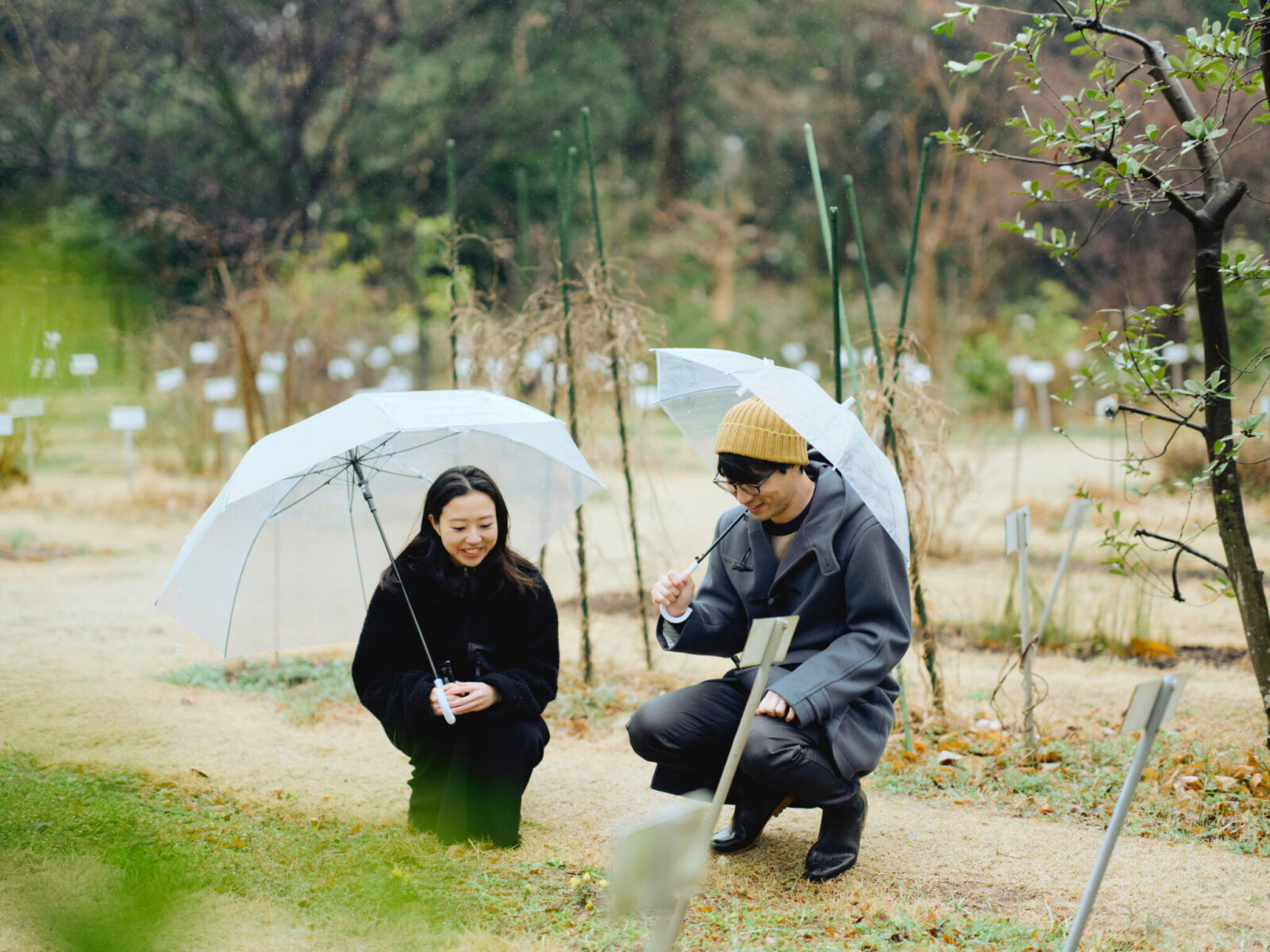
Seeds for Shikohin 01
We learned that some plants not only contain caffeine in their leaves, but also in their flowers. We would like to study how many of such plants exist and explore potential new shikohin products made out of these flowers. Possibilities include making caffeinated honey or flower teas.
Seeds for Shikohin 02
Japan has many trees that have strong fragrances. As Mochizuki shared his idea to make tree wood liquors, perhaps there are other shikohin products that can utilize the scent of trees. This also made us curious about the relationship between fragrances and religion or rituals, so it would be interesting to delve into fragrant woods from this perspective as well.
Seeds for Shikohin 03
We would like to continue researching why complex fragrances make a more appealing shikohin product. In this interview we found some hints through evolutionary science, but other perspectives could be studied to determine what kind of shikohin products people find to be more preferable.
Translation: Sophia Swanson
Editor. Born and raised in Kagoshima, the birthplace of Japanese tea. Worked for Impress, Inc. and Huffington Post Japan and has been involved in the launch and management of media after becoming independent. Does editing, writing, and content planning/production.
